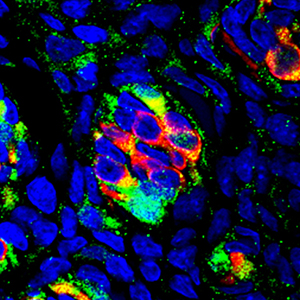 Smart Citations
Smart CitationsSee how this article has been cited at scite.ai
scite shows how a scientific paper has been cited by providing the context of the citation, a classification describing whether it supports, mentions, or contrasts the cited claim, and a label indicating in which section the citation was made.
Expression profile of the zinc transporter ZnT3 in taste cells of rat circumvallate papillae and its role in zinc release, a potential mechanism for taste stimulation
Zinc is an essential trace element, and its deficiency causes taste dysfunction. Zinc accumulates in zinc transporter (ZnT)3-expressing presynaptic vesicles in hippocampal neurons and acts as a neurotransmitter in the central nervous system. However, the distribution of zinc and its role as a signal transmitter in taste buds remain unknown. Therefore, we examined the distribution of zinc and expression profiles of ZnT3 in taste cells and evaluated zinc release from isolated taste cells upon taste stimuli. Taste cells with a spindle or pyriform morphology were revealed by staining with the fluorescent zinc dye ZnAF-2DA and autometallography in the taste buds of rat circumvallate papillae. Znt3 mRNA levels were detected in isolated taste buds. ZnT3-immunoreactivity was found in phospholipase-β2-immunopositive type II taste cells and aromatic amino acid decarboxylase-immunopositive type III cells but not in nucleoside triphosphate diphosphohydrolase 2-immunopositive type I cells. Moreover, we examined zinc release from taste cells using human transient receptor potential A1-overexpressing HEK293 as zinc-sensor cells. These cells exhibited a clear response to isolated taste cells exposed to taste stimuli. However, pretreatment with magnesium-ethylenediaminetetraacetic acid, an extracellular zinc chelator - but not with zinc-ethylenediaminetetraacetic acid, used as a negative control - significantly decreased the response ratio of zinc-sensor cells. These findings suggest that taste cells release zinc to the intercellular area in response to taste stimuli and that zinc may affect signaling within taste buds.
Downloads
Publication Facts
Reviewer profiles N/A
Author statements
- Academic society
- N/A
- Publisher
- PAGEPress Publications, Pavia, Italy
Citations
10.1186/s12903-024-05050-7
10.3390/app132111617
How to Cite

This work is licensed under a Creative Commons Attribution-NonCommercial 4.0 International License.
PAGEPress has chosen to apply the Creative Commons Attribution NonCommercial 4.0 International License (CC BY-NC 4.0) to all manuscripts to be published.

 https://doi.org/10.4081/ejh.2022.3534
https://doi.org/10.4081/ejh.2022.3534





